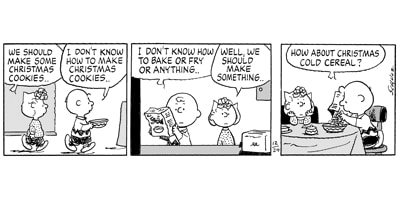Christmas Cereal or ‘Fatty-man’
If you have Norwegian family members or friends you may have heard of these Christmas cookies, which were Sparky’s favorites.
Every year, his longtime friend, Fern Wick, would arrive at the studio with a tin of Fattigmann (which is their real name). Sparky allowed himself just two a night so that they would last the whole month of Christmas festivities.

Cover of a Norwegian Christmas cookbook.
Because it was something he loved so much, I had wished for a long time that I could have a party making Fattigmann to serve at the Museum.
They say if you wait long enough or wish hard enough, you know, the answer is suddenly right in front of you.
This past spring, I met Cordelia Holst, the new Executive Director of the Sebastopol Cultural Center (following long-time ED, Diana Rich), at the center’s annual Dinner and Author Talk.
In talking to Cordelia about how she came to be there, I learned she had grown up in Sebastopol and had just returned after living 13 years in Norway.
Cordelia had met her husband Jørgen when he was going to art school in San Francisco. And after a few years in the States, they moved to Norway near Jørgen’s family.
Cordelia told us that her language study was not easy, but she did finally master it.
I immediately asked her about Fattigmann and whether she knew how to make it. She didn’t, but promised that she would ask her mother-in-law when they visited in the summer.
Cordelia was good to her word, and she and Jørgen came to the Museum to give us directions and support.

Cordelia and Jørgen Holst.
And so the baking party began!
After all the ingredients were mixed together, we turned the batter out onto a floured surface and gathered it into a large ball. You have to let it chill before rolling it out a small portion at a time on a lightly-floured surface.

Cordelia overseeing my dough rolling.
You want to avoid handling the dough too much, as this will yield tough cookies. With a rolling pin, we rolled the dough as thin as we could get it.
The thinner the dough, the crispier the cookies!

Volunteers Patti, Bev, and Patty Wick—whose mother-in-law made the Fattigmann for Sparky.

Volunteers, Larry (with a makeshift rolling pin) and Idelle help roll the dough.

Cordelia Holst cutting the rolled dough.
Once we rolled the dough, we used a fluted pastry cutting wheel to make diamonds by cutting parallel lines about two inches apart, then across those lines on a diagonal.

Here I am making diamond shapes out of the dough.
In the center of each diamond, you have to make a slit about 1/3 the length of the cookie. Then you take one pointed end and fold it through the slit, pulling slightly to make a little curly shape…or really any shape you like will work.
The dough was harder to fold than I remember—but that was 30 years ago.

Cordelia Holst, Kristi Lucas-Hayden (our Volunteer Director), Jørgan Holst, and me.

Shaped Fattigmann dough ready to be fried (and the best twist we could produce).
Using a deep fryer, you can dial in the temperature and put the raw dough into the basket before lowering it into the hot oil. If you don’t have a deep fryer, just make sure to have the oil deep enough that the cookies will have room to float, about four inches is good.

Fattigmann in the deep fryer.
The shaped dough goes into a deep fryer for a minute or so until golden brown.
While they’re cooling, dust the cookies with sifted powdered sugar (as much as you like).

Completed Fattigmann ready to eat.
Don’t they look beautiful!
The recipe we at the Museum used is below—in Norwegian and English.
I hope you enjoy making them as much as we did. The real challenge will be only eating two per night!
Merry Christmas and happy baking!
—Jean Schulz






